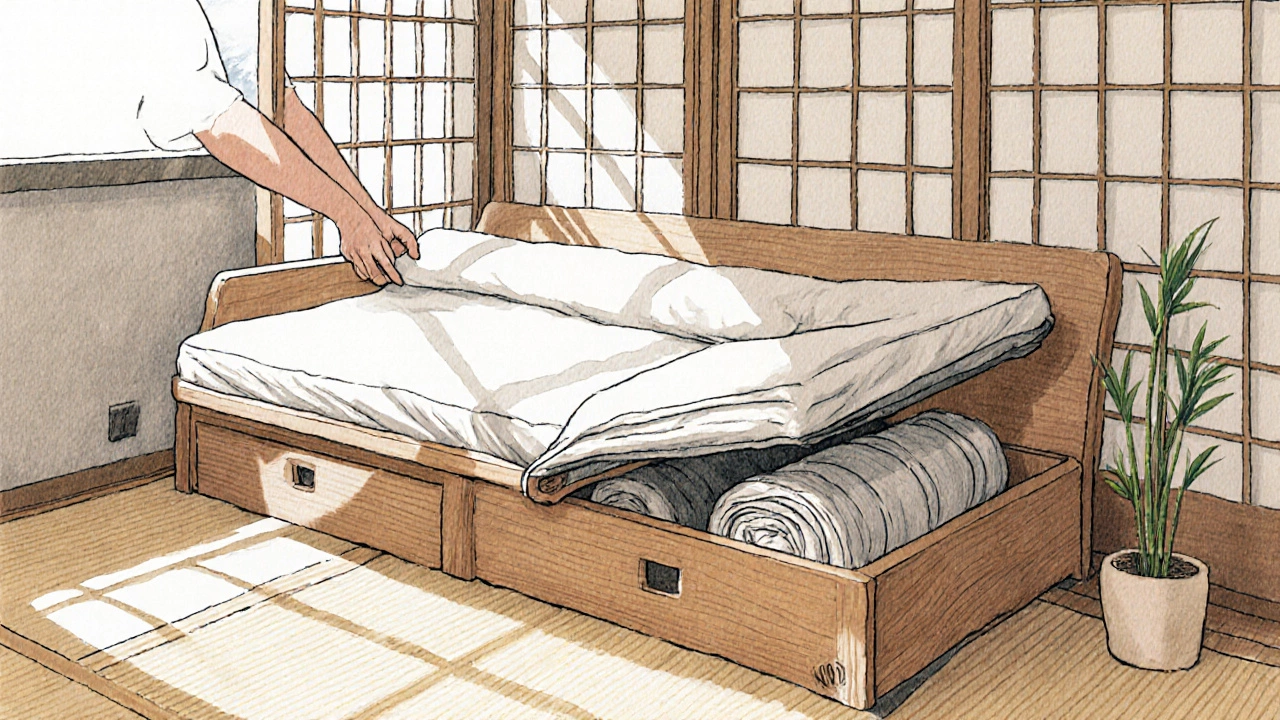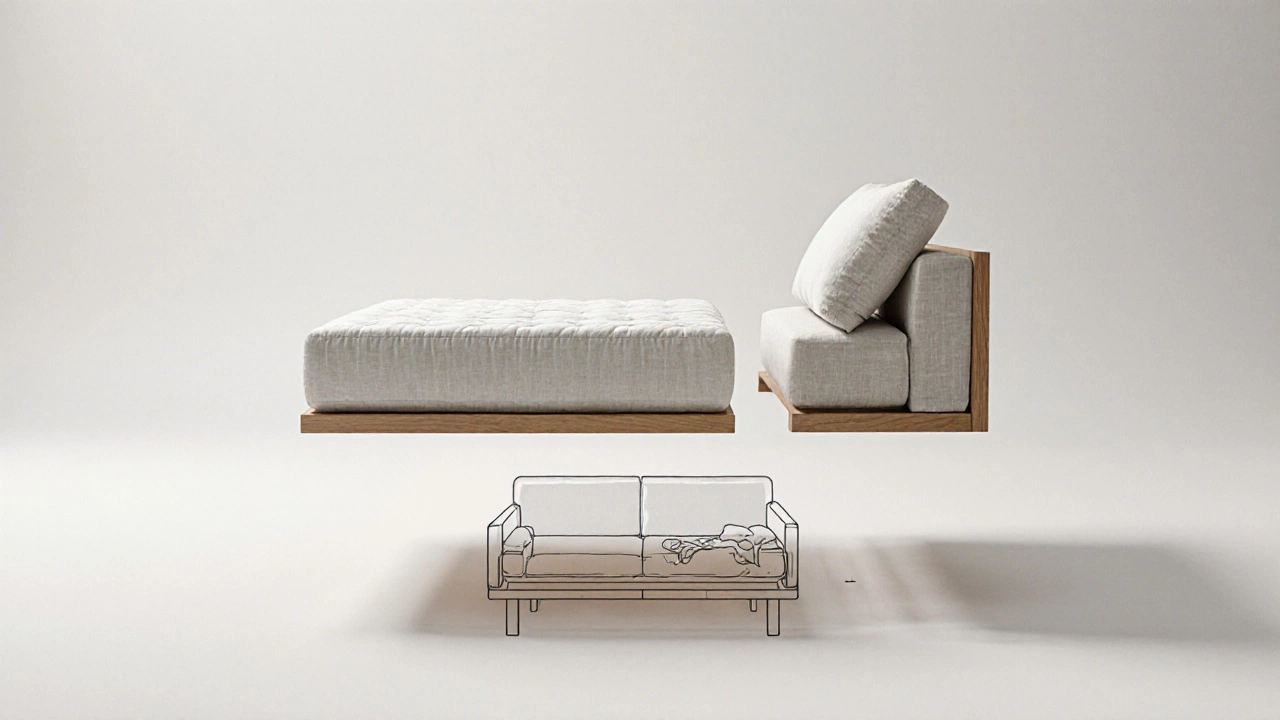Space Calculator for Japanese Sofa Beds
Room Dimensions
Calculate how much space a Japanese sofa bed will occupy in your living area
Ever walked into a tiny apartment in Tokyo and wondered how people fit a bed, a couch, and a living room into 20 square meters? The answer often starts with a Japanese sofa bed. It’s not just a fold-out couch with a thin mattress. It’s a design philosophy built around minimalism, functionality, and smart use of space.
What Makes a Japanese Sofa Bed Different?
A Japanese sofa bed isn’t just a Western-style sofa with a hidden mattress. It’s typically a low-profile frame, often made of wood or metal, with a firm, thin mattress that doubles as a seating cushion during the day and a sleeping surface at night. Unlike American sofa beds that use bulky metal frames and thick spring mattresses, Japanese versions rely on simplicity. The mattress is usually a high-density foam or cotton-filled futon, designed to be rolled up or stored away easily.
These beds sit just a few inches off the floor. That’s intentional. In traditional Japanese homes, people sleep on the floor using tatami mats. The low height keeps the room feeling open and airy. When you sit on one, you’re not sinking into deep cushions-you’re sitting upright, close to the ground, which supports better posture and makes it easier to get up.
How It Works: No Hidden Mechanisms
You won’t find complicated hinges, levers, or pull-out rails on a Japanese sofa bed. There’s no clunking sound when you convert it. Instead, you simply remove the cushions, lay the mattress flat, and you’ve got a bed. Some models come with a built-in storage compartment underneath for bedding or extra pillows. Others are designed as modular units-you can rearrange the pieces to fit different room shapes.
Because there’s no metal frame pushing up through the fabric, the surface stays smooth. No lumps, no springs poking through. The mattress is usually about 3 to 4 inches thick, firm enough to support your spine, but light enough to fold or carry by yourself. That’s why many people in Japan use them in small apartments, guest rooms, or even as a daily bed in studios.
Why People in the West Are Choosing Them
In cities like London, New York, or here in Leeds, space is getting tighter and pricier. Renting a one-bedroom apartment often means giving up on having a separate guest room. A Japanese sofa bed solves that without looking like a piece of furniture from a 1990s motel.
Compared to traditional sofa beds, which can look clunky and feel uncomfortable after a few nights, Japanese versions are sleek. They blend into modern interiors. A simple beige or charcoal fabric, clean lines, and low height make them look more like a designer lounge chair than a fold-out bed. People who value minimalism love them. So do renters who can’t drill holes or make permanent changes to their space.
They’re also easier to move. One person can lift and carry a Japanese sofa bed. No need for two friends and a dolly. That’s a big plus if you’re moving often or live in a building without an elevator.
Materials and Comfort: What to Look For
Not all Japanese sofa beds are made the same. The mattress is the most important part. Avoid ones with thin polyester fill or cheap foam that flattens out after a month. Look for high-density polyurethane foam (at least 25 kg/m³ density) or natural cotton batting layered over a supportive base. Some premium models include a thin layer of memory foam on top for pressure relief.
The frame matters too. Solid wood-like oak, beech, or bamboo-is durable and long-lasting. Avoid particleboard or MDF, which can warp or break under repeated use. Metal frames are lighter but can feel cold and noisy over time.
For the cover, removable and washable fabric is a must. Cotton linen blends breathe well and don’t trap heat. Avoid synthetic materials that make you sweat at night. A zip-off cover lets you clean it easily or swap it out for a seasonal look.

How to Use One in Your Home
Don’t treat it like a regular sofa. If you sit on it all day with your legs curled under you, the mattress will sag unevenly. Use it like a low seat: sit upright, keep your feet flat on the floor, and avoid leaning back too far. It’s designed for short-term sitting, not all-day lounging.
At night, make sure the mattress is fully flat and the frame is stable. Add a thin topper if you’re used to softer beds. Many users find that adding a 2-inch memory foam topper makes the transition from Western beds much easier.
Pair it with a low side table and a floor lamp. Keep the area around it clear. The beauty of this design is how it opens up the room. Don’t pile up clutter around it. Let it breathe.
Who Should Buy One?
Japanese sofa beds are perfect for:
- Small apartments or studio homes
- Guest rooms that double as offices or reading nooks
- People who move often
- Minimalist interiors
- Those who prefer sleeping on a firm surface
They’re not ideal if you need a plush, cloud-like bed. If you have back problems and need extra cushioning, or if you’re over 6 feet tall and need more legroom, you might find them too restrictive. But for most people in tight spaces, they’re the smartest solution out there.
How Much Do They Cost?
Prices vary based on materials and brand. Basic models start around £200-£300. These usually have a simple wood frame and a standard foam mattress. Mid-range options, with better foam, removable covers, and solid wood frames, cost £400-£650. High-end versions, like those from Japanese brands such as Muji or Nitori, can go up to £800-£1,000. They often include storage drawers, matching cushions, and eco-friendly materials.
Compare that to a traditional sofa bed that costs £500-£1,200 but takes up more space and feels less comfortable. A Japanese version gives you more value per square foot.

Where to Find Them
You can find Japanese-style sofa beds at stores like Muji, Nitori, IKEA (look for their ‘FJÄLLBO’ or ‘SÖDERHAMN’ models), or online retailers like Wayfair and Amazon. But don’t just search for “Japanese sofa bed.” Try terms like “low profile futon sofa,” “Japanese style floor bed,” or “modular floor sofa.” That’ll give you better results.
Check reviews carefully. Look for comments about mattress firmness, ease of conversion, and durability after 6+ months of use. Many buyers regret choosing a model that feels great at first but flattens out too quickly.
Real-Life Example: A Leeds Apartment
A friend of mine lives in a 320-square-foot flat in Headingley. She uses a Japanese sofa bed as her main sleeping space. During the day, it’s her couch, her reading chair, and her desk area when she works from home. She added a small wooden tray that fits over the armrest for her coffee and laptop. At night, she rolls out the mattress, adds a thin memory foam topper, and sleeps soundly. No one ever guesses it’s a bed. She says it’s the best space-saving decision she’s ever made.
Final Thoughts
A Japanese sofa bed isn’t a gimmick. It’s a practical response to the way people actually live now-smaller spaces, more movement, less clutter. It doesn’t try to be everything. It does one thing well: turns from seat to bed without drama. If you’re tired of bulky furniture that eats up your living room, it might be the quiet revolution your home needs.
Is a Japanese sofa bed comfortable to sleep on?
Yes, if you prefer a firm sleeping surface. The mattresses are typically 3-4 inches thick with high-density foam or cotton, offering solid support without sinking. People with back pain often find them more comfortable than soft mattresses. If you’re used to plush beds, adding a 2-inch memory foam topper improves comfort significantly.
Can I use a Japanese sofa bed every night?
Absolutely. Many people in Japan use them as their primary bed. They’re built for daily use. The key is choosing a high-quality mattress with durable foam and a sturdy frame. Avoid cheap models with thin padding-they’ll flatten out quickly. Regularly flipping or rotating the mattress helps extend its life.
Do Japanese sofa beds require special bedding?
No, standard twin or full-size sheets fit most models. Because they’re low to the ground, fitted sheets stay in place better than on raised beds. A flat sheet and a lightweight duvet work best. Avoid thick, bulky comforters-they make the bed feel too high. Many users prefer a thin quilt or cotton coverlet for warmth without bulk.
Are Japanese sofa beds good for guests?
They’re ideal. Guests appreciate the clean, quiet design and the fact that it doesn’t look like a “guest bed.” It blends into the room. Since it’s firm and supportive, most people sleep well. Just make sure the mattress is clean and fresh, and offer a soft pillow or two. It’s more welcoming than a fold-out couch with visible metal springs.
How do I clean a Japanese sofa bed?
Most have removable, machine-washable covers. Vacuum the mattress surface regularly to remove dust and debris. For stains, spot clean with mild soap and water. Never soak the mattress-let it air dry completely before using it again. If the frame is wood, wipe it with a damp cloth and dry immediately. Avoid harsh cleaners that can damage the finish.
Do Japanese sofa beds work in cold climates?
Yes, but you’ll need to adjust. Since they sit low to the floor, they can feel colder in winter. Use a thick rug underneath and add a wool blanket or heated mattress pad. Layering bedding helps-start with a fitted sheet, add a thin cotton quilt, then a duvet. Avoid synthetic materials that trap moisture. Many users find that the firmness actually helps circulation, making them feel warmer than expected.



